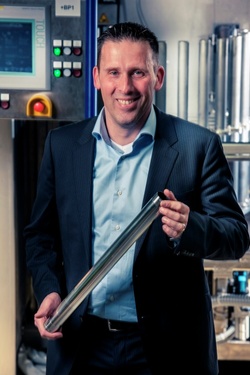News Release from Aalberts Surface Treatment GmbH
Wind Industry Profile of
Efficient and environment-friendly selective hard chrome plating processes
The parts to be coated are placed in mechanisms that allow the plating electrolyte to access only the intended areas for treatment. Any parts of a component that do not need to be coated are covered in a special tool with an incorporated sealing system. The selective plating method called SELGA-COAT® CHROME is also considerably more efficient and more environmentally friendly than conventional hard chrome processes.
Please read an interview with Hay Hulsman, Managing Director of AHC Benelux BV. The company of the AHC Group operates the SELGA-COAT® CHROME process at its facility in Venlo, The Netherlands.
Question: Mr. Hulsman, hard chrome isn't really anything new. What's unique about your process?
Hay Hulsman: That's true. Technical hard chrome plating has seen a wide range of applications in the automotive industry and mechanical engineering. The especially valued properties of hard-chrome layers are hardness, corrosion resistance, wear resistance and tribological properties, as well as thermal and chemical resistance.
The unique feature of our process, SELGA-COAT® CHROME, is that we operate with a five-to-six-times-higher current density and a very high deposition rate of 5 micrometres per minute as compared to conventional hard chrome. The energy consumption for each produced layer thickness is considerably lower.
Question: And what was the driving factor behind the development of your process?
Hay Hulsman: As usual, it was the customer requirements that we responded to with innovation. In this case, a selective hard-chrome plating was required: a layer deposition only on the areas of the part that are affected during use. That's also the idea behind the name SELGA-COAT: selective galvanization.
Question: How does one envision selective galvanization exactly?
Hay Hulsman: Simple: The chrome comes to the part, not the part to the chrome.
In the conventional hard-chrome method, the parts to be coated are loaded onto a rack and submerged in an electrolyte bath where an electric current is applied. In this way, the parts are completely coated, unless the areas that shouldn't be treated are covered in advance. That's very time-consuming and costly.
For a medium to large number of parts, the SELGA-COAT® CHROME process is ideal. The parts are placed in mechanisms that allow the plating electrolytes to access only the intended areas for treatment.
The selective plating method is also considerably more efficient and more environmentally friendly than conventional hard chrome processes.
Question: Why is that? You also use a chromic acid electrolyte, don't you?
Hay Hulsman: First of all, the facility is a closed system and doesn't have any open tanks of chromic acid solution; therefore, the operator never comes in contact with hexavalent chromium. Next, the system operates with zero wastewater and practically complete recirculation of the used chemicals. That means the disposal of used chemicals is reduced to an absolute minimum.
Given the future restrictions on the use of hexavalent chromium as of 2017 according to the EU chemical regulation, REACH, our selective, environmentally-friendly process presents an ideal alternative.
Question: Which base materials can be treated with your process, and which layer properties can be expected?
Hay Hulsman: SELGA-COAT® CHROME is used on carbon or hardened steel parts. Treatment of other materials, such as aluminium, is still in the developmental phase.
The high current density helps us achieve a layer hardness of up to twelve hundred HV: that's around ten to fifteen percent higher than those of conventional hard chrome. The layer tolerances are also significantly lower. With a layer thickness of twenty-five micrometres, we have a tolerance of only plus-or-minus two micrometres.
Depending on the quality of the base material, we achieve such a low roughness that in most cases, a post-grinding step for the treated area is unnecessary.
Question: So which parts are hard-chrome plated with your process?
Hay Hulsman: We see treatment potential primarily in the automotive industry and mechanical engineering, because on the one hand parts are mass-produced in large quantities...and on the other hand...the layer requirements are very challenging.
Currently we're plating suspension tubes for motorcycle forks: these require an extremely precise hard-chrome layer that's also corrosion and wear resistant. We're thinking particularly about other oblong, rotationally symmetrical parts, such as axles, spindles, shafts or pipes. Of course, any other carbon or hardened steel part can be hard-chrome plated as long as a selective treatment is appropriate.
We have all the necessary expertise to meet any individual requirements.
- Source:
- AHC
- Email:
- info@ahc-surface.com
- Link:
- www.ahc-surface.com/...


